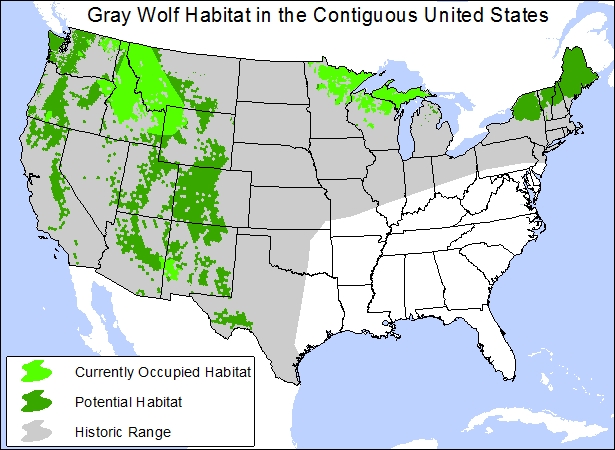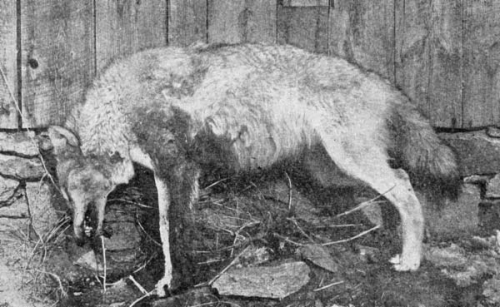
A grey wolf observed in Amalik Bay. NPS Photo/D. Kopshever.
The wolf is perhaps the most misunderstood and polarizing animal species ever encountered by human-kind. Fear, hatred, and demonization of the wolf have deep roots in Western culture. Looking back at American history with the wolf shows why human concepts of morality and ethics should never be imposed upon wild animals. In the wolf’s case, the results have been catastrophic.
Just a few hundred years ago, the wolf was one of the most widespread and successful land mammals of North America. After what one researcher has called “the most relentless and ruthless persecution one species has ever waged against another,” the wolf has been exterminated from more than 90% of its original range. Alaska is the last significant refuge for the American grey wolf. National Parks like Katmai protect wolves from their sole predator - humans.

Map courtesy of Curt Bradley/Center for Biological Diversity.
For many people today, the wolf represents wildness, strength, and intelligence - but this is a newly found respect for the wolf among Americans, and it is not all encompassing. Some, particularly those who live in the few areas with present wolf populations, feel threatened by the wolf and are compelled to perpetuate an all out war against the world’s most misunderstood creature.

A grey wolf in Amalik Bay. NPS Photo/D. Kopshever.
The wolf’s greatest downfall has been the fact that it relies on the same food sources as modern humans. North America was once home to as many as 57 million hoofed animals - bison, antelope, deer, elk, and bighorn sheep - today less than 8% of that number exist, mostly composed of deer. As European settlers moved through the continent, the American grasslands were extirpated of big game and replaced by sprawling farmlands. As a result, some wolves survived by preying on the domesticated animals that humans brought in their wake of destruction. Soon, a relationship of coexistence was deemed impossible by the people who’s livelihood depended on livestock.

Two men stand with a mountain of Bison Skulls. Photo courtesy of Burton Historical Society.
By the beginning of the 19th century, wolves were hunted and trapped by ranchers and professional bounty hunters alike. State sponsored bounties on wolf carcasses made wolf hunting a lucrative business in some places. These bounties remained in some states as late as 1965. Even today, bounties exist for the wolf’s cousin - the coyote. Many states, including Wyoming, New Mexico, Arizona and Utah, will pay hunters as much as $50 per coyote pelt. Like the wolf, the coyote is being killed in masse because of a misapplication of ethics upon wild animals.
The widespread view of the wolf as an evil, revolting creature has resulted in the destruction of thousands of wolves and often brutal torture of the animal. The luckier recipients of man’s wrath were poisoned or shot. Others were burned alive or scalped; some had their mouths wired shut or their eyes scorched by branding irons, then were released back into the woods to slowly starve to death.

A dead wolf, later collected for bounty. Photo courtesy of A.R. Harding.
Such are the possibilities when wild animals are confined to the rules of human kind. A wolf is not evil for being a wolf - for doing what it needs to survive. Nor is any other animal. This idea is beginning to take hold with people across the country. Work has begun to restore the wolf as a valuable part of our natural ecosystems, but the battle to redress what has been done is just beginning, and is not without opposition. Fear and hatred of the wolf - born from the imposition of human ethics upon these wild animals - is still present with some Americans. Alaska’s wolf population is not endangered or threatened. As a result, America’s last frontier is also one of the last places where wolf hunting is permitted on a significant scale.

A grey wolf in Amalik Bay. NPS Photo/D. Kopshever.
Katmai is one of the few remaining sanctuaries where wolves can thrive with relatively little contact from humans. Protected places like Katmai are extremely important for the wolf’s survival. More wilderness areas, free of human settlement, roads, and livestock are needed for the wolf to survive as it once did. But that is only one part of a solution. People and wild animals can coexist together, if the right attitudes and behaviors are embraced.
The wolf in these photographs was observed in Amalik Bay, on the Katmai coast.

A grey wolf in Amalik Bay. NPS Photo/D. Kopshever.
